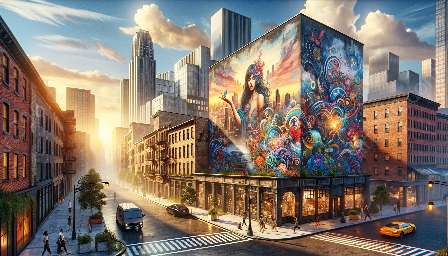Cultural preservation and expression play a crucial role in shaping the identity of communities around the world. This encompasses a wide range of practices, including traditional arts, customs, and urban art forms such as street art and graffiti. In this discussion, we will delve into the complexities and nuances of cultural preservation and expression, and examine the dynamic relationship between street art, graffiti, and the preservation of cultural heritage.
The Significance of Cultural Preservation
Cultural preservation refers to the safeguarding and promotion of traditions, knowledge, and artifacts that are integral to a community's history and identity. It is a means of maintaining a connection to the past and passing on valuable heritage to future generations. Cultural preservation also fosters a sense of belonging and pride among community members, as they recognize and celebrate their unique cultural heritage.
Expression Through Street Art and Graffiti
Street art and graffiti serve as powerful mediums for cultural expression and communication. These urban art forms allow individuals to convey their thoughts, emotions, and perspectives in a public space, thereby contributing to the collective narrative of a community. Both street art and graffiti often reflect the cultural influences, social issues, and personal experiences of the artists, serving as visual representations of cultural expression.
Street Art vs. Graffiti
When discussing cultural preservation and expression, it is essential to understand the distinction between street art and graffiti. Street art encompasses various forms of artistic expression displayed in public areas, often with the intention of beautifying urban spaces and engaging with the community. Alternatively, graffiti is commonly associated with unauthorized markings, typically consisting of stylized lettering or images that may be viewed as vandalism.
The Impact on Societal Values and Heritage
Street art and graffiti have the potential to significantly influence societal values and heritage. By incorporating cultural symbols, themes, and historical references into their work, artists can contribute to the preservation and revitalization of cultural traditions within urban environments. Furthermore, these art forms often provide a platform for marginalized voices to be heard, raising awareness of important social and cultural issues.
Preserving Cultural Heritage in Urban Spaces
Preserving cultural heritage in urban spaces involves a delicate balance between promoting artistic expression and maintaining respect for public property. Initiatives that support legal street art programs and collaborative mural projects can effectively integrate cultural preservation efforts with urban development, fostering a sense of unity and pride within communities.
Conclusion
Cultural preservation and expression are fundamental aspects of human society, and they continue to evolve alongside contemporary urban art movements. Street art and graffiti serve as poignant reflections of cultural identity and expression, intersecting with the broader discourse of cultural preservation. By recognizing the value of these art forms, and embracing their potential to contribute to the preservation of cultural heritage, societies can cultivate a more inclusive and vibrant cultural landscape.

